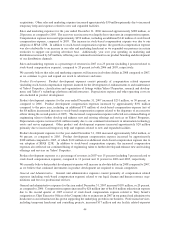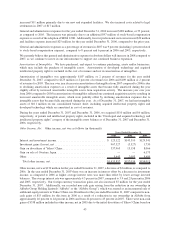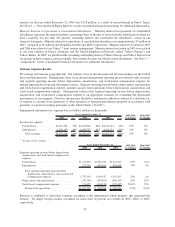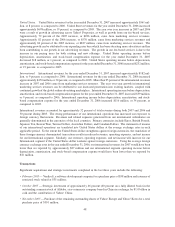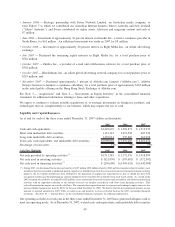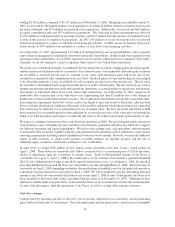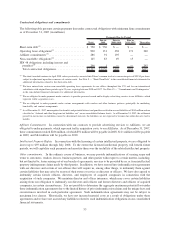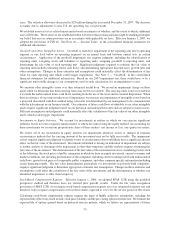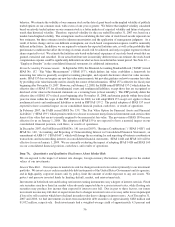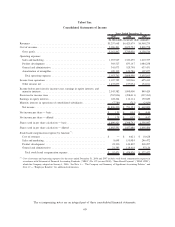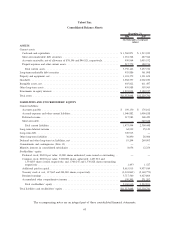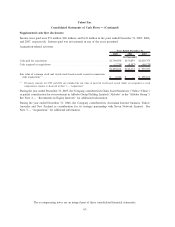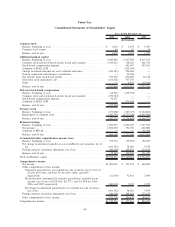Yahoo 2007 Annual Report Download - page 56
Download and view the complete annual report
Please find page 56 of the 2007 Yahoo annual report below. You can navigate through the pages in the report by either clicking on the pages listed below, or by using the keyword search tool below to find specific information within the annual report.In 2006, we reversed an earn-out accrual related to a prior acquisition, which resulted in a $10 million reduction to
operating expenses in the consolidated statements of income for which there was no comparable activity in 2007.
As of December 31, 2007, we did not have any relationships with unconsolidated entities or financial partnerships,
such as entities often referred to as structured finance or special purpose entities, which would have been established
for the purpose of facilitating off-balance sheet arrangements or other contractually narrow or limited purposes. As
such, we are not exposed to any financing, liquidity, market, or credit risk that could arise if we had engaged in such
relationships.
Critical Accounting Policies and Estimates
Our discussion and analysis of our financial condition and results of operations is based upon our consolidated
financial statements, which have been prepared in accordance with GAAP. The preparation of these consolidated
financial statements requires us to make estimates, judgments, and assumptions that affect the reported amounts of
assets, liabilities, revenues and expenses, and the related disclosure of contingent assets and liabilities. We base our
estimates on historical experience and on various other assumptions that we believe are reasonable under the
circumstances, the results of which form the basis for making judgments about the carrying values of assets and
liabilities that are not readily apparent from other sources. Actual results may differ from these estimates.
An accounting policy is considered to be critical if it requires an accounting estimate to be made based on
assumptions about matters that are highly uncertain at the time the estimate is made, and if different estimates that
reasonably could have been used, or changes in the accounting estimate that are reasonably likely to occur, could
materially impact the consolidated financial statements. We believe that the following critical accounting policies
reflect the more significant estimates and assumptions used in the preparation of the consolidated financial
statements.
Management has discussed the development and selection of these critical accounting estimates with the Audit
Committee of our Board of Directors and the Audit Committee has reviewed the disclosure below. In addition, there
are other items within our financial statements that require estimation, but are not deemed critical as defined above.
Changes in estimates used in these and other items could have a material impact on our financial statements.
Revenue Recognition. Our revenues are generated from marketing services and fees. Marketing services revenues
are generated from several offerings including: the display of textual, rich media advertisements, display of text
based links to advertisers’ Websites, listing based services, and commerce-based transactions. Fees revenues
includes revenue from a variety of consumer and business fee-based services. While the majority of our revenue
transactions contain standard business terms and conditions, there are certain transactions that contain non-standard
business terms and conditions. In addition, we may enter into certain sales transactions that involve multiple
element arrangements (arrangements with more than one deliverable). We also enter into arrangements to purchase
goods and/or services from certain customers. As a result, significant contract interpretation is sometimes required
to determine the appropriate accounting for these transactions including: (1) whether an arrangement exists; (2) how
the arrangement consideration should be allocated among potential multiple elements; (3) when to recognize
revenue on the deliverables; (4) whether all elements of the arrangement have been delivered; (5) whether the
arrangement should be reported gross as a principal versus net as an agent; (6) whether we receive a separately
identifiable benefit from the purchase arrangements with our customer for which we can reasonably estimate fair
value; and (7) whether the arrangement should be characterized as revenue or a reimbursement of costs incurred. In
addition, our revenue recognition policy requires an assessment as to whether collection is reasonably assured,
which inherently requires us to evaluate the creditworthiness of our customers. Changes in judgments on these
assumptions and estimates could materially impact the timing or amount of revenue recognition.
Deferred Income Tax Asset Valuation Allowance. We record a valuation allowance to reduce our deferred income
tax assets to the amount that is more likely than not to be realized. In evaluating our ability to recover our deferred
income tax assets we consider all available positive and negative evidence, including our operating results, ongoing
tax planning and forecasts of future taxable income on a jurisdiction by jurisdiction basis. In the event we were to
determine that we would be able to realize our deferred income tax assets in the future in excess of their net recorded
amount, we would make an adjustment to the valuation allowance which would reduce the provision for income
54


